How to Propagate a Rosemary Plant from Stem Cuttings
This post may contain affiliate links, which means that I may receive a commission if you make a purchase using these links. As an Amazon Associate I earn from qualifying purchases.
Fresh rosemary is one of the most flavorful and fragrant herbs in the kitchen. Learn how to take rosemary cuttings from an established mother plant and grow new plants in containers that can be moved outside in summer and indoors in winter.

Rosemary (Rosmarinus officinalis) is a perennial herb in USDA Hardiness Zones 8 and warmer where it can be planted in the garden and can grow 4 feet tall and spreads about 4 feet wide depending on the variety.
For those of us gardening in colder zones, growing rosemary in containers allows us to bring it in during the winter to keep it alive.
My rosemary plant is going on seven years old this year. It grows in a container spends the summer outside on the porch. The rosemary plant is brought inside when the weather turns cold in fall, and it overwinters on a south-facing windowsill.
By the time spring rolls around, the rosemary usually looks raggedy from reduced light and heat fluctuations. Sometimes so many needles dry up and drop off that I wonder if it can possibly survive.
Once warmer weather arrives, the rosemary plant is hardened off, and returned outside for summer. After only a few weeks, it begins to grow new shoots, and the branches fill in with thicker foliage. I am amazed every time it happens.
This is the perfect time to start a new batch of plants. These fresh, green stems are the ones you want to select for softwood stem cuttings.
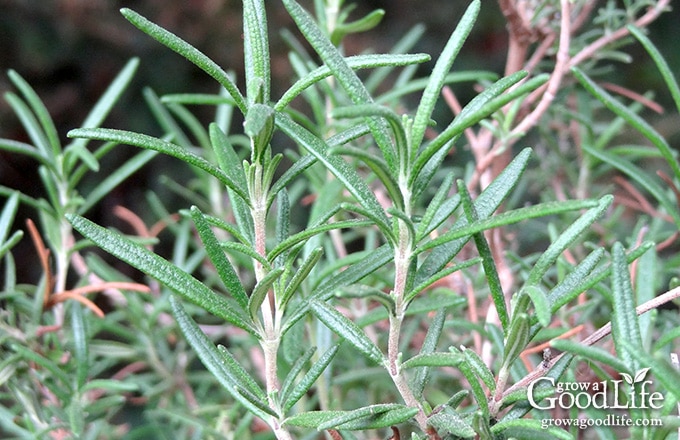
Benefits of Growing Rosemary Plants from Stem Cuttings
Instead of purchasing a new rosemary plant every year or starting new plants from seeds, try growing your own from stem cuttings. Some of the benefits of growing rosemary from cuttings vs. starting from seeds include:
- Earlier Harvest: A rooted rosemary plant from a cutting will mature quicker than a plant started from seed. Rosemary seeds tend to have low germination rates and take a long time to sprout and grow. A rosemary stem cutting will reach a usable size in just a few months, so you will be able to harvest rosemary sooner.
- Same as the Mother Plant: The rosemary plant you will grow from cuttings will be an exact clone of the mother plant and have the same flavor, disease resistance, and growth.
- Extra Plants for Free: A single plant can provide numerous cuttings without risking the health of the plant. So you can line your kitchen windowsill with several plants that will smell wonderful when you brush your hand against them.
How to Grow Rosemary from Cuttings
Here are steps to taking rosemary cuttings from an established mother plant and grow new rosemary plants in containers that can be moved outside in summer and indoors in winter.
Step 1: Select new shoots from the mother plant
Choose healthy stems with fresh growth. The younger shoots will have green stems that are flexible. Avoid older brown, woody stems.
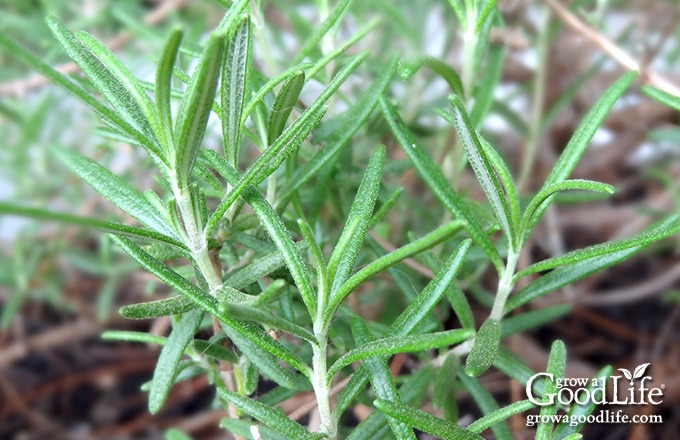
Step 2: Take stem cuttings
Use sharp scissors and snip the rosemary stem about 5 to 6-inches back from a fresh growing tip. Cut plenty of extra stems in case some fail to grow roots.
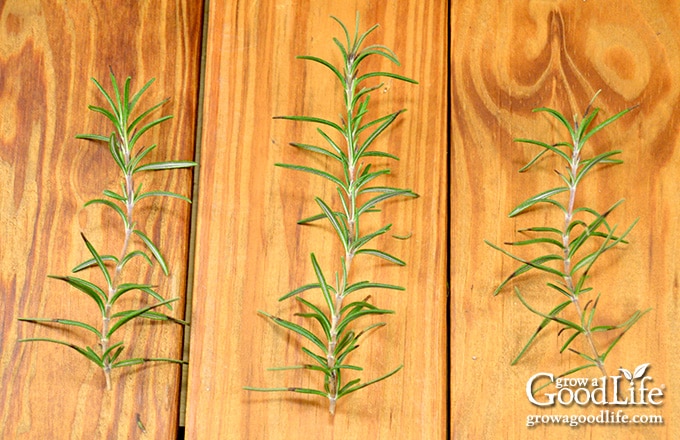
Step 3: Strip the lower leaves
Grasp your fingers around the stem, and gently strip off the lower 2-inches of needles from the stem of the rosemary cutting.
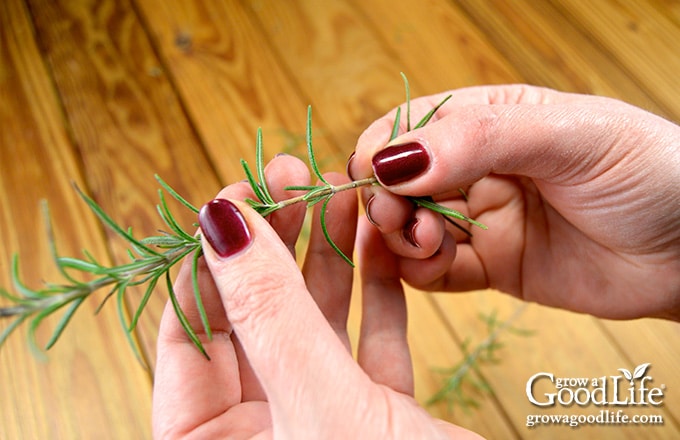
Step 4: Place cuttings in water
Stick the stems in a jar of water and place the jar in a warm place away from direct sunlight. Change the water every couple days, replacing with room temperature water. The fresh water provides dissolved oxygen and prevents the cuttings from rotting.
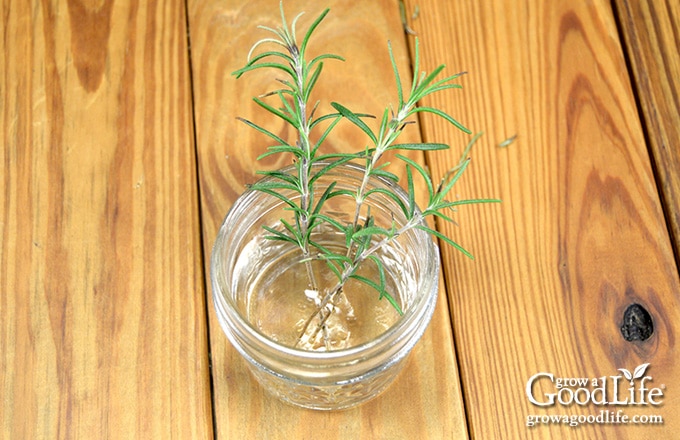
The rosemary stem cuttings should grow roots in a few weeks depending on the temperature. It can take longer in colder temperatures. After 4 to 8 weeks it should be apparent if the rosemary cuttings have survived. The cuttings that do not survive will be brown and shed needles. If your rosemary cutting is still alive, give it some more time.
Step 5: Pot up the stem cuttings once roots develop
Your rosemary cuttings are ready to place in soil when you see 4 to 6 roots on each stem that are at least 1/2-inch long. Use a sandy soil mix that drains well. Mix equal parts all-purpose potting soil and sharp sand. Or use cactus-potting soil. Use a sandy soil mix that drains well. Mix equal parts all-purpose potting soil and sharp sand. Or use cactus-potting soil.
Fill a 4-inch pot with slightly damp potting soil for each rosemary cutting. Use a pencil to make a 3 to 4-inch hole into the soil. Place the cutting in the hole with care to avoid damaging the roots. Cover gently and water thoroughly.
Place the newly potted rosemary plant in indirect light or in filtered sunlight until roots become established, and then move to direct light, at least 6 to 8 hours per day. Keep the potting soil moist until you see new growth.
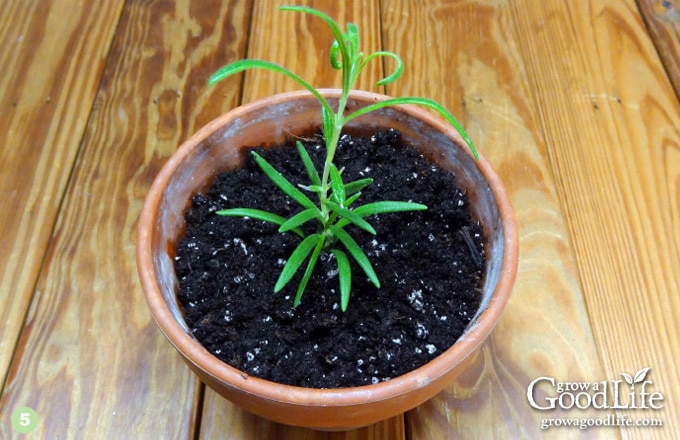
Let the new plants to put on some growth before harvesting. Once the plant is 6-inches tall, harvest by cutting stems as needed. New growth will continue forming on the stem. Rosemary grows slowly so don’t harvest more than 1/3 of the plant at one time.
How to Care for Rosemary Plants
Rosemary is a rather robust plant once it is established and growing. Here are some tips to keep your plant healthy and producing:
- Grow in a sunny location. Rosemary thrives in 6-8 hours of direct sun in the summertime.
- Water when the soil feels dry. Once established, rosemary likes to stay on the dry side. Allow top inch of soil to dry out between watering, and then water thoroughly.
- Re-pot as the plant gets larger and the roots fill the container. A rosemary plant that grows in a container can reach 1 to 3 feet high. Just keep transplanting to a larger container when the roots fill the pot.
- Prune rosemary frequently. The more you trim, the bushier the plant grows. Prune the plant after it flowers to keep it compact.
Tips for Growing Rosemary Indoors in Winter
Rosemary is native to Mediterranean climates so it prefers a hot, sunny, and humid atmosphere. Here are some tips for keeping your rosemary plants alive indoors during winter:
- Quarantine: If you have houseplants, it is a good idea to quarantine your rosemary plants when you bring them indoors. Keep the plants in a separate location for a while to be sure there are no hitchhikers, pests, or disease.
- Light: Locate your rosemary plants in a bright south-facing window. Alternatively, you can use grow lights and keep your plants happy during the winter months.
- Water: Try to keep the potting mix evenly moist. Over watering will cause the plant to rot. If the soil is too dry, the plant will wither and die. Water when the soil dries out at the surface and let the extra moisture drain.
- Temperature: Rosemary likes it a bit on the cooler side during the winter. Keep the plants away from heat sources and wood stoves. About 60 to 65 degrees is ideal.
- Humidity: Winter heating keeps us warm, but it also saps moisture from the air and drops the humidity. Compensate by misting your rosemary plant frequently, running a humidifier, or placing your rosemary plant on a tray of pebbles and water to increase the humidity around your plant.
- Pests and Diseases: Common pests for indoor rosemary plants are red spider mites, aphids, spittlebugs, and whiteflies. These pests suck on the plants and cause the foliage to wilt and dry up. Inspect your rosemary plants frequently for pests and control with organic insecticidal soap. Diseases such as root rot, powdery mildew, and mold are all signs of too much moisture and poor air circulation. Allow the top inch of soil to dry out between watering, and then water thoroughly allowing extra water to drain out of the bottom of the pot. Run a fan to improve air circulation around your plants.
This article was originally published March 23, 2015. It has been updated with additional information, new photos, and video.
You May Also Like:
Good planning is key to a successful vegetable garden
Whether you are new to growing your own food or have been growing a vegetable garden for years, you will benefit from some planning each year. You will find everything you need to organize and plan your vegetable garden in my PDF eBook, Grow a Good Life Guide to Planning Your Vegetable Garden.


Super easy to propagate from a big outdoor mother plant. Especially in Southern California. Can even place cuttings straight into moist areas in the garden to root and transplant later.
My rosemary plant is 22+ years old and has a six food spread. Needing to get it half it’s size. Wish me luck!!
Wow, I wish we could grow rosemary that large here in the north. Good luck!
You can up to zone 5b-6 in the Northern East Coast in the US as well as northern parts of Europe. I grow it in France for over 9 years now and it spends all winters out and absolutely huge now, so much it needs metal railing supports. Just look for the ‘Arp’ Rosemary as it’s the hardiest for cold weather.
Hi, I brought my rosemary plant indoors for the winter. It is growing very straggly weak thin branches, should I be cutting them off, or should I leave well enough alone?
Karen, Just leave it alone for now. The weak and thin branches are pretty typical when growing rosemary indoors in winter. The plant is experiencing lower temperatures and less light than it is used to. Make sure the plant is getting as much sunlight as it can by placing it in a south facing window and try misting the foliage every now and then. Wait to prune it until it begins to improve in spring.
My potted rosemary is outside on the patio and looking somewhat dreadful. I think it’s from root rot. Can I prune out the brown stems and move the plant inside at once or will it go into shock and die?
I’m in South Carolina (zone 8).
Tammy, It might be worth trying to save the plant.
Not
Sure if your plant lived but would have tried to repot in fresh soil
Thanks for the questions and answers. I enjoy cooking with rosemary, especially turkeys.
I’ve potted my stem and it is growing so I’m very happy. How do I get more shoots to come up from the soil? Or would I need another cutting to add to the one I have?
Jill, Rosemary is a slow growing plant. It will take a while, but eventually more shoots will sprout from the stem. Try to rooting more stems if you want more plants quicker.
Great article! My question is if I stick a branch in soil will it root up just as quickly? I was trying to move the plant upwards as the stems were growing a bit wild and accidentally broke one of the branches! I stuck it back in the pot, so crossing my fingers it will root ip quickly. It is a well established piece that broke, the stem is not soft at all. Thank you in advance for your help.
Catherine, I haven’t had much luck rooting from a branch, but it is worth a try. Just keep it well watered. Let me know how you make out.
Hi Rachel! how long should these roots be before transplanting? Thank you
Daphne, The roots can be very small, about 1/2-inch.
How many roots are needed in a water rooting before planting?
Linda, I would wait for about 4-6 roots before transplanting.
I have recently got a rosemary plant from a store, it is a decent sized plant and is quite healthy. I am curious to know if it it okay to propagate from my new plant or if I should wait to see if it is a good plant, as in disease resistance, flavor and growth speed. Also, which side should I put the cuttings in, top or bottom?
Miah, I would go ahead and try propagating rosemary from a purchased plant. Select shoots that are still soft and not woody. The cut end goes into the water.